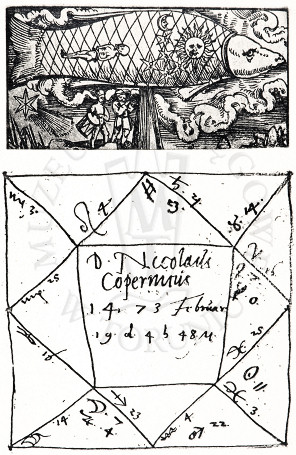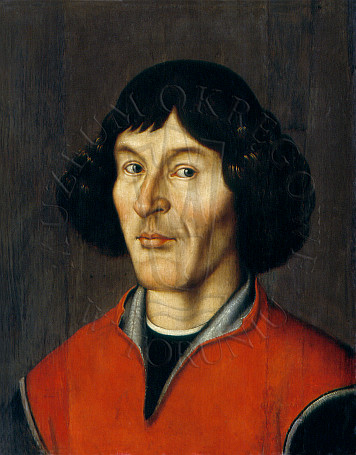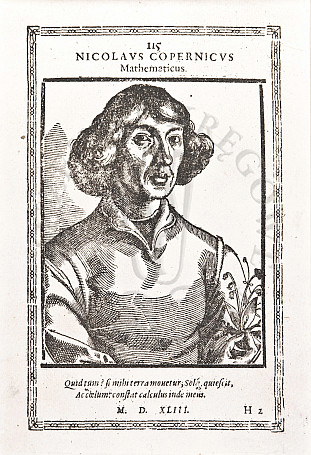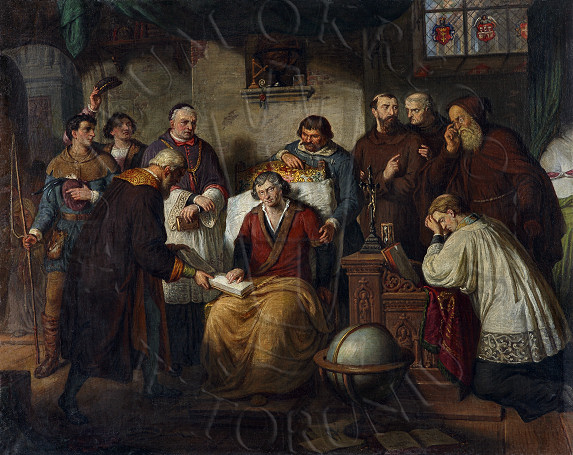Outline biography
Nicolaus Copernicus (1473-1543): astronomer, economist, cartographer, physician, Warmian Canon
Born on 19 February 1473 in Toruń (Thorn) Nicolaus was the eldest
son of a Toruń alderman, also Nicolaus (d. after 18 July 1483),
and Barbara Watzenrode, a daughter of a rich patrician, Lucas Watzenrode (d.
1462). Copernicus’ ancestors came from Silesia
 and his father was first
a Kraków merchant who had made his fortune in the copper trade with Gdańsk.
He settled in Toruń in 1455 where he received his citizenship as a merchant
and later became a city councillor of the Old Town of Toruń. The future
astronomer had an younger brother, Andreas, and two sisters: Barbara who
later became a Benedictine nun and abbess in Chełmno (Culm), and
Katharina who later married the city councillor Barthel Gertner (Gärtner).
and his father was first
a Kraków merchant who had made his fortune in the copper trade with Gdańsk.
He settled in Toruń in 1455 where he received his citizenship as a merchant
and later became a city councillor of the Old Town of Toruń. The future
astronomer had an younger brother, Andreas, and two sisters: Barbara who
later became a Benedictine nun and abbess in Chełmno (Culm), and
Katharina who later married the city councillor Barthel Gertner (Gärtner).
Copernicus was baptized in the parish church of St John the Baptist
and St John the Evangelist (presently the cathedral basilica) and started
his formal education in the parish school ran by this church. After his
father’s untimely death (before February 1484) the Copernicus brothers’
maternal uncle Lucas Watzenrode (1447-1512), who was appointed Bishop of
Warmia in 1489, took them under his protection and saw to their education.
They were sent to the Jagiellonian University in Kraków in the autumn
of 1491, and where Copernicus studied mathematics and natural sciences
most probably until 1495. From the autumn of 1496 until the summer of 1501
the brothers Copernicus studied law in Bologna, which was to prepare them
both for ecclesiastical careers. Thanks to their uncle’s patronage and
protection they both received Warmian canonries in Frombork (Nicolaus in
1497, Andreas in 1499) and from then on they could study at the expense
of the chapter. Little is known about the legal education of Nicolaus’s
brother. Although he did get the chapter’s permission to continue
his studies in Italy in late July 1501, he soon contracted leprosy and
died in 1518. Nicolaus was a diligent student of the University of Bologna
but it is not certain, however, when he earned his master’s degree in
liberal arts, however he completed the academic courses in Roman law (civil
law) and canon law required by the university. He also learnt Greek but
 above all he gave himself up to his beloved astronomy maintaining close
contacts with Professor Domenico Maria Novara (1454-1504) with whom he
conducted astronomical observations. These were later continued in Rome
in 1500 where, allegedly, he also gave private lectures during which he
criticized the geocentric system of the universe.
above all he gave himself up to his beloved astronomy maintaining close
contacts with Professor Domenico Maria Novara (1454-1504) with whom he
conducted astronomical observations. These were later continued in Rome
in 1500 where, allegedly, he also gave private lectures during which he
criticized the geocentric system of the universe.
In 1501 Copernicus made a short trip to Warmia and on 27 July got the chapter’s permission to study medicine in Italy for two years. He enrolled in the University of Padua, famous for its high-level instruction in medical sciences, and stayed there from the autumn of 1501 until the summer of 1503 though without earning an academic degree. Although pressed to return to Warmia, he left for nearby Ferrara where he earned a doctorate in canon law on 31 May 1503. In the same year he finally returned to Prussia and took up residence in Lucas Watzenrode’s castle in Lidzbark (Heilsberg). He owed to his uncle a scholasteria (a sinecure) at the Church of the Holy Cross in Wrocław (1503) and Pope Julius II’s permission to receive two other ecclesiastical benefices in the future (from 1508). Watzenrode planned to carve a great political and ecclesiastical career for Copernicus, most probably seeing his nephew as his successor as Bishop of Warmia.
Copernicus did not live up to his uncle’s expectations, however, and did not take higher holy orders choosing to devote all his spare time to his beloved astronomy instead. In 1509 he formulated the first outline of the heliocentric view of the universe which he had drafted in his Commentariolus (Commentary on celestial motions), manuscript copies of which reached many men of learning and made Copernicus’ name famous in Europe. His expertise and experience could not have passed unnoticed even in faraway Rome, from where in mid-1513 a summons was sent addressed to the best mathematicians in Europe to take part in work on the reform of the Julian calendar. The letter of invitation addressed to Copernicus himself and signed by Paul of Middleburg, Bishop of Fossombrone, prompted Copernicus’ decision to build an observation post (pavimentum) in the garden of his residence (curia). There is evidence that Copernicus did answer the summons from Rome and sent his own calendar reform proposal of which Pope Leo X was informed in 1516. The text of Copernicus’ draft has not been found, however.
His duties while in Frombork involved, first and foremost, ensuring the good financial standing of the cathedral chapter and administering its vast estates. To the very end of his life Copernicus held many of the most important offices within the chapter including those of inspector, chancellor, executor of last wills and, on the death of Bishop Fabianus Lusianus in 1523, that of Administrator General of the Bishopric of Warmia. During the Polish-Teutonic armed conflict he skilfully organized the defence of Olsztyn (Allenstein) Castle, and after the Peace Treaty of Kraków had been signed, and Ducal Prussia converted into a secular duchy in 1525, he became engaged in the economic revitalization of Warmia, populating deserted areas and bringing the land left barren into cultivation, while simultaneously maintaining good neighbourly relations with Prince Albrecht of Ducal Prussia.
Copernicus wrote some treatises on the reformation of Prussian coinage
(1517, 1519, 1526) and participated in the assemblies of the ‘Prussian
estates’ convened to discuss monetary reform. He was also a cartographer,
a highly respected physician and a translator of Greek literary texts written
by the Byzantine man-of-letters Theophylact Simocatta. He reached such
great fame that, upon
 the death of Bishop Mauritius Ferber in 1537, the
Polish King, Sigismund the Old, nominated Copernicus (along with three
others) as a royal candidate for the bishopric of Warmia; from these the
cathedral chapter was to later select Bishop Ferber’s successor.
the death of Bishop Mauritius Ferber in 1537, the
Polish King, Sigismund the Old, nominated Copernicus (along with three
others) as a royal candidate for the bishopric of Warmia; from these the
cathedral chapter was to later select Bishop Ferber’s successor.
Burdened with many responsibilities, Copernicus nevertheless continued his astronomical research and writing his vast treatise of the Earth’s orbit, De revolutionibus. Though encouraged by his closest friends, especially by Tiedemann Giese (1480-1550), and supported by many scholars in Europe and the Holy See who showed great interest in the new theory, Copernicus could not pluck up the courage to publish the results of his work contradictory to the evidence of the human senses and the letter of the Holy Scripture. He finally decided to do so thanks to the enthusiasm and assistance of Georg Joachim Rheticus (1514-74), a young Wittenberg mathematician who visited him in May 1539. It was a very difficult period in the astronomer’s life. He had been recently accused of illegal cohabitation with his housekeeper Anna Schilling who was forced to leave Frombork. Copernicus therefore most willingly accepted a personal invitation extended by Tiedemann Giese, the Bishop of Chełmno (Culm), and spent the whole summer with his friend in Lubawa (Löbau). It must have been there that he finally agreed that Rheticus should publish a summary of his work titled Narratio prima. Printed in Franz Rhode’s shop in 1540, the text stirred up such a great interest in the academic world that the summary was reprinted in Basel the following year. Rheticus also assisted ‘his master’ in making all the necessary corrections and amendments to the text, while Copernicus charged his disciple with printing the full text of his treatise in Johannes Petreius’s printing house in Nuremburg. It is well worth mentioning that on the title page of his manuscript he placed information on his origins: Nicolai Copernici Torinensis [i.e. ‘from Toruń’].
Composed of six ‘books’, the 400-page manuscript of De revolutionibus
written between 1515-30, and amended and corrected over the following decade,
had a foreword written by the author and a letter dedicated to Pope Paul
III in which the astronomer argued the legitimacy of the heliocentric theory.
Book One contained the justification for the central position of the Sun
and the Earth’s triple motion, supplemented by an explication of triangulation
and spherics and a decimal sine function
 table calculated by Copernicus
himself. Devoted to specialized knowledge of spherical astronomy, the theory
of procession, movements of the moon (with a method of calculating lunar
eclipses) and the theory of planetary motions, the remaining five books
were meant exclusively for mathematicians and astronomers.
table calculated by Copernicus
himself. Devoted to specialized knowledge of spherical astronomy, the theory
of procession, movements of the moon (with a method of calculating lunar
eclipses) and the theory of planetary motions, the remaining five books
were meant exclusively for mathematicians and astronomers.
Unfortunately, because Rheticus had to go to Leipzig where he worked as a lecturer in mathematics, he was not able to oversee the printing of ‘his master’s manuscript’ until it was completed. Therefore, the work was published with a changed title (De revolutionibus orbium coelestium). Moreover, instead of the author’s strong assertion of the correctness of his theory, expressed in the letter appended and dedicated to the Pope, the book had an unsigned foreword written by the Lutheran theologian Andreas Osiander reducing his theory to a mere hypothesis. The already seriously ailing Copernicus might not have been able to read the newly-printed book because at the beginning of December 1542 he suffered a stroke and the left side of his body was paralyzed. He died on 24 May 1543 and was buried in Frombork Cathedral.
Tiedemann Giese and Georg Joachim Rheticus made every effort to denounce the forgery and both wrote their own biographies of Copernicus (not surviving). Despite strong opposition put up by both Protestant and Catholic theologians, De revolutionibus generated deep academic interest in Europe, hence its succeeding editions (Basel 1566 and Amsterdam 1617). Only after the work had been placed on the Index of Prohibited Books did interest wane among Catholic scholars, while Protestant scholars challenged the heliocentric theory until the 18th c. The first Polish translation of De revolutionibus (O Obrotach) by Jan Baranowski appeared as late as 1845 in Warsaw.
The autograph manuscript of Copernicus’ book is kept in the Jagiellonian University Library in Kraków. Like his other works, the text was written in Latin, which in the 15th and 16th c. was the language of the élite. Copernicus for the most part used the same language in his correspondence, only using German in his letters addressed to Prince Albrecht and to the municipal authorities of Prussian cities. Copernicus also knew Greek and undoubtedly Polish which he must have used while touring the chapter’s estates and in conversations with settlers from the Mazowsze region.
Nicolaus Copernicus University
| Timeline |

